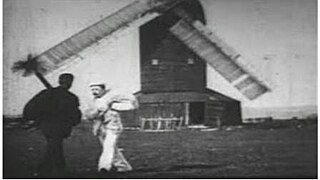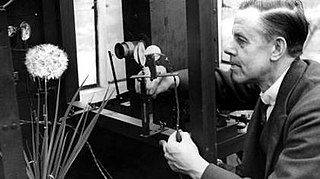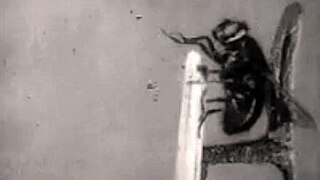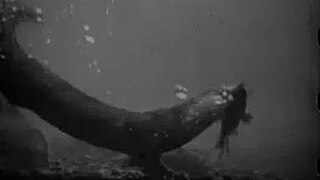Related Research Articles

Jack Cardiff, was a British cinematographer, film and television director, and photographer. His career spanned the development of cinema, from silent film, through early experiments in Technicolor, to filmmaking more than half a century later.

A nature documentary or wildlife documentary is a genre of documentary film or series about animals, plants, or other non-human living creatures, usually concentrating on video taken in their natural habitat but also often including footage of trained and captive animals. Sometimes they are about wildlife or ecosystems in relationship to human beings. Such programmes are most frequently made for television, particularly for public broadcasting channels, but some are also made for the cinema medium. The proliferation of this genre occurred almost simultaneously alongside the production of similar television series.

Rough Sea at Dover is an 1895 British short black-and-white silent film, shot by Birt Acres.

The Miller and the Sweep is a 1898 British short black-and-white silent comedy film, directed by George Albert Smith, featuring a miller carrying a bag of flour fighting with a chimney sweep carrying a bag of soot in front of a windmill, before a crowd comes and chases them away. The film, according to Michael Brooke of BFI Screenonline, "was one of the first films made by G.A. Smith, shortly after he first acquired a camera," and is also, "one of the earliest films to show a clear awareness of its visual impact when projected."

Oliver Gregory Pike, FZS, FRPS. was a British naturalist, wildlife photographer, author and early nature documentary pioneer, specialising in the study of bird life. "His claim to significance," according to Bryony Dixon of BFI Screenonline, "lies in the groundbreaking techniques he developed to capture animals in their natural habitats and in the fact that he passed this knowledge on."

Edgar Percival Chance (1881–1955) was a British businessman, ornithologist and oologist who amassed a collection of 25,000 birds' eggs. He is noted for his pioneering studies on the parasitic breeding behaviour of the common cuckoo.

Explosion of a Motor Car is a 1900 British short black-and-white silent comedy film, directed by Cecil M. Hepworth, featuring an exploding automobile scattering the body parts of its driver and passenger. "One of the most memorable of early British trick films" according to Michael Brooke of BFI Screenonline, "was one of the first films to play with the laws of physics for comic effect." It features one of the earliest known uses in a British film of the stop trick technique discovered by French filmmaker Georges Méliès in 1896, and also includes one of the earliest film uses of comedy delay – later to be widely used as a convention in animated films – where objects take much longer to fall to the ground than they would do in reality. It is included in the BFI DVD Early Cinema: Primitives and Pioneers and a clip is featured in Paul Merton's interactive guide to early British silent comedy How They Laughed on the BFI website.

Spiders on a Web is a 1900 British short silent documentary film, directed by George Albert Smith, featuring a single shot close-up of two spiders trapped in an enclosure. The film is, according to Michael Brooke of BFI Screenonline, "less formally ambitious," than the director's, "groundbreaking multiple close-up study Grandma's Reading Glass (1900), made the same year, but is nonetheless, "one of the earliest British examples of close-up natural history photography, predating Percy Smith's insect studies by a decade."

Frank Percy Smith was a British naturalist and early nature documentary pioneer, who explored time-lapse photography, microphotography, microcinematography, and animation.

The Strength and Agility of Insects is a 1911 British short silent documentary film, directed by F. Percy Smith, featuring close-ups of houseflies and other insects secured and juggling various objects with their feet. The films in this series, which included The Acrobatic Fly (1910), "caused an absolute furore when they were first shown to the public," and, according to Jenny Hammerton of the BFI, Smith, whose stated intention "was of course to entertain the public, but also to demonstrate the strength and agility of those insects we might unthinkingly squash or swat when they settle on our lunch," "was forced to justify his methods in the press, guaranteeing that there was no trickery involved and certainly no cruelty."

Yarmouth Fishing Boats Leaving Harbour is an 1896 British short black-and-white silent documentary film, directed by Birt Acres, featuring a fleet of fishing smacks leaving the harbour at Great Yarmouth, Norfolk, UK.

An Otter Study is a 1912 British short black-and-white silent documentary film, produced by Kineto, featuring an otter in its natural habitat, including groundbreaking footage of underwater hunting scenes. The film provided a novel treatment of the creature, which had previously appeared on film only as the victim of hunt films, with the unique underwater footage, shot by a cameraman behind glass in a tank concealed on the bed of the river in the opening scene, and a concluding scene, excised from the surviving print, in which it escapes the hunters. It was long thought lost until footage from a 1920s Visual Education re-release of the film, re-edited under the supervision of Professor J Arthur Thomson of Aberdeen University's Natural History Department, was rediscovered.

The Biter Bit is an 1899 British short black-and-white silent comedy film, produced by Bamforth & Co Ltd, featuring a boy playing a practical joke on a gardener by grasping his hose to stop the water flow and then letting go again when the gardener looks down it to check. The film, "is an English remake" of Auguste and Louis Lumière's L'Arroseur Arrosé (1895), according to Michael Brooke of BFI Screenonline, "providing a good illustration of how early film production companies cheerfully plagiarised each other's work" with "a few minor differences between, most notably a rather greater sense of space and depth in the Bamforth version" and "three distinct planes to the action". It is included in the BFI DVD Early Cinema: Primitives and Pioneers and a clip is used in Paul Merton's interactive guide to early British silent comedy How They Laughed on the BFI website.

Comic Costume Race is an 1896 British short black-and-white silent actuality film, directed by Robert W. Paul, featuring comic costume scramble at the Music Hall Sports on 14 July 1896 at Herne Hill, London. The music hall sports day was an annual charity event consisting of other events such as egg and spoon races and three-legged races. The film is the best surviving pictorial record of the Music Hall Sports. It is not known who the race participants are.

Tommy Atkins in the Park is an 1898 British short black-and-white silent comedy film, directed by Robert W. Paul, featuring a couple courting in a park who are forced to use desperate measures to get rid of a stout matron who interrupts them. The film was a remake of Alfred Moul's The Soldier's Courtship (1896). It is included on the BFI DVD R.W. Paul: The Collected Films 1895-1908 and a clip is featured in Paul Merton's interactive guide to early British silent comedy How They Laughed on the BFI website.

Army Life; or, How Soldiers Are Made: Mounted Infantry is a 1900 British short black-and-white silent propaganda actuality film, directed by Robert W. Paul, featuring the King's Own Royal Lancaster Regiment riding over a plain. The film, which premiered on 18 September 1900 at the Alhambra Theatre in London, England, "is all that appears to remain of one of R.W. Paul's most ambitious projects," which, according to Micahael Brooke of BFI Screenonline, "had it survived in a more complete form," "would undoubtedly be considered one of the most important precursors of the modern documentary."
British Instructional Films was a British film production company which operated between 1919 and 1932. The company's name is often abbreviated to BIF.
Variety in Sepia is a television Variety special that was filmed live on 7 October 1947 at the RadiOlympia Theatre, Alexandra Palace, London, and was aired on BBC TV.

The Tempest is a 1908 British-made silent film directed by film pioneer Percy Stow who specialised in trick photography.
References
- ↑ Dixon, Bryony. "Secrets of Nature (1922–33)". BFI Screenonlinee. Retrieved 15 November 2021.
- 1 2 "Unveiling the Secrets of Nature". The Bioscope. 19 July 2010. Retrieved 15 November 2021.
- ↑ Secrets of Nature website
- ↑ "Secrets of Nature: The Cuckoo's Secret (1922)". wildfilmhistory.org. Archived from the original on 29 December 2011. Retrieved 24 April 2011.
- ↑ Dixon, Bryony. "Cuckoo's Secret, The (1922)". BFI Screenonlinee. Retrieved 15 November 2021.
- ↑ Babbidge, Clare (9 January 2009). "Birdwatcher gave 1922 cuckoo clue". BBC News, West Midlands. Retrieved 15 November 2021.
- ↑ "Secrets of Nature: The Battle of the Ants". BFI Film & TV Database. Archived from the original on 23 October 2012. Retrieved 24 April 2011.
- ↑ "Secrets of Nature: Fathoms Deep Beneath the Sea". BFI Film & TV Database. Archived from the original on 9 September 2011. Retrieved 24 April 2011.
- ↑ Dodd, Adam. "Skilled Insect Artisans (1922)". BFI Screenonlinee. Retrieved 15 November 2021.
- ↑ "Secrets of Nature: The Sparrow-Hawk (1922)". wildfilmhistory.org. Archived from the original on 29 March 2012. Retrieved 24 April 2011.
- ↑ "Secrets of Nature: The White Owl". BFI Film & TV Database. Archived from the original on 23 October 2012. Retrieved 24 April 2011.
- ↑ "Secrets of Nature: Busy Bees". BFI Film & TV Database. Archived from the original on 23 October 2012. Retrieved 24 April 2011.
- ↑ "Secrets of Nature: Floral Co-operative Societies". BFI Film & TV Database. Archived from the original on 23 October 2012. Retrieved 24 April 2011.
- ↑ "Secrets of Nature". Total Film. Archived from the original on 24 September 2012. Retrieved 24 April 2011.
- ↑ "Secrets of Nature: The Plants of the Pantry". BFI Film & TV Database. Archived from the original on 23 October 2012. Retrieved 24 April 2011.